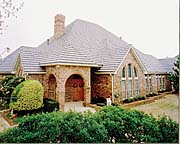Running the Architectural Relay

Unprofessional? Probably. Funny? Definitely! But the semi-heated exchange above also illustrates an important point about the reason why architects and roofing contractors don’t always get along: They don’t completely understand what makes each other tick. Most metal roofing contractors would never presume to tie themselves to a per-square price without knowing anything about the building, and similarly, most architects would scoff at the notion that they could quote a straight price to design a home. Of course, the argument could have been avoided had the contractor been willing to compromise on a ballpark figure, but the architect had already needled him to the point where he was annoyed and looking for a fight.
Most likely, the origins of the architect/contractor animosity have something to do with the fact that the architect trusts the integrity of his design, and thus a certain degree of liability, in the hands of a roofing contractor whose quality of work he can’t be sure of. Subsequently, that roofing contractor trusts that the architect’s details will work flawlessly with his tried and true installation methods. The number one complaint of architects about roofing contractors is that they try to shortcut and don’t follow the plans. The number one complaint of roofing contractors about architects is that their plans are not applicable to the “real world” and are therefore useless. Over the course of a building’s construction, architects and roofing contractors are a little like a relay team that can’t agree on the best technique to hand off the baton.
Metal Adds Market Share
In the metal roofing industry, though, the extent to which contractors and architects are working toward understanding each other is seemingly growing proportionally with the market share of the industry itself. Architects have been instrumental in this growth, both commercially and residentially, as more and more recognize metal’s durability and beauty. This growth does have a slight downside, though.Because of the sheer volume of metal roofing product types and profiles available, many architects are specifying metal roofing without a firm grasp of the relative applicability of certain metals, systems and profiles in relation to one another. Therefore, when metal roofing contractors are able to position themselves as a technical resource for architects, they find that their own product lines might often be looked at more favorably at specification time. Any materials or advice that a metal roofing contractor can provide to make the specification process easier for an architect increases the chances that that particular metal roofing product or system will, in fact, end up on the building and that contractor will be the one installing it. Yes, architects do look at the performance and aesthetics of the product, but for some, the factor that contributes the most to the product’s use is its ease of specification.
Becoming situated as a technical resource does take a little hard work and planning. Any contractor that has tried is well aware of the fact that architects are pretty unreceptive to cold calls — in person or on the phone. In a perfect world, the architect and contractor would each meet half way for an unbiased exchange of information. In the real world, since it is the metal roofing contractor looking for the boost to the bottom line, it’s usually he that has to take the bull by the horns.
Once a relationship has been initiated, though — and this can be done in literally dozens of ways, from an AIA/CES Lunch ‘N Learn program to sponsoring an AIA Component’s chapter meeting — it still takes a little extra work to establish the trust that will firmly entrench the contractor as the “go-to” metal roofing guy. Remember, the reason for much of the animosity between architects and contractors in the first place is a failure to understand each other. Therefore, the more that the contractor is able to speak in the architect’s “native tongue,” the more of a connection is made and the more trust is built. Actors, writers and politicians know that they are only as effective as the strength of the bond they can create with their audiences. Good salesmen know this as well.
Learn to Communicate
The first and most basic step in creating empathy with architects is using a straight-forward, to-the-point style of communication. The necessity of this is especially evident if we consider the heated exchange in the first paragraph. Beating around the bush incites ill-will. When discussing the merits of a particular metal roofing product, architects are only interested in the facts, not the fluff. The facts don’t include, “This is the most attractive roofing system on the market” or “It will make the home the centerpiece of the neighborhood,” or pretty much any similar type of catchy marketing jargon.What architects are most interested in are characteristics like the approximate cost, UL ratings, energy efficiency (again, with a quantitative analysis, not generic statements like “It makes the home cooler”), and flashing details. But most importantly, they’re concerned with whether or not the metal roof system they are considering is the best possible choice, aesthetically and functionally, to meet the goals of their design. This ultimately includes a discussion of the metal roof system’s limitations and/or failure points, topics usually left back at the office during a traditional sales presentation. Here is where a contractor can really ingratiate himself the most with an architect because such candidness demonstrates an understanding for and appreciation of what architects like to call “good design.”
“Good design” is an architectural idiom that amalgamates reliability, usability, elegance, efficiency and maintainability into one recognizable catch phrase. At its most basic level, good design means design that solves problems. For obvious reasons, this is a major tenet of an architect’s professional modus operandi. It is important for a metal roofing contractor to show a respect for good design and be able to explain how and why metal roofing is a component of good design — namely its durability, energy efficiency, weather resistance and long life.
Green is Key
While understanding good design is probably most important to gaining credibility as a technical resource, recognizing other aspects of the design process only boosts that trust, and by extension, the bottom line! These days, architects are finding themselves under more pressure than ever to design green, and as a result, more and more firms are setting certification goals for projects based upon the Leadership in Energy and Environmental Design Rating System. Finding high-quality building products that fit with LEED protocol is a constant challenge for architects. With the technological updates to the paint pigments used in some metal roofing systems, and the boosted reflectance and thus energy efficiency that result, many metal roofing systems now fit the LEED bill perfectly for steep sloped applications.Contractors that carry these “Hi-R” systems, and invest the time to learn and speak intelligently about LEED can thus show an architect how he can achieve the LEED rating point for reflective roofing, but not have to sacrifice color choice — something about which an architect will probably be pretty excited!
Helping to educate architects about metal roofing products that work with LEED reiterates a salient point about “selling” to architects in general. In an architect’s ideal world, marketing and education are synonymous. This statement is sort of the heart of the matter; the overarching strategy for securing credibility with architects as a technical resource. Architects want a teacher, not a salesman. Granted, it’s often tough to resist the temptation of selling, since the ultimate goal of spending the time with the architects is to sell more product, but architects truly appreciate a contractor that is able to keep the discussion strictly education-based. One of the main reasons contractors balk at organizing an AIA/CES program is that they don’t appreciate the benefit of spending the entire time with an architectural firm, but not getting to talk specifically about their own products and services. The point is, the time spent is not wasted and many metal roofing contractors are realizing this. And as they do, that architect-contractor baton pass is becoming smoother and smoother.
Looking for a reprint of this article?
From high-res PDFs to custom plaques, order your copy today!




